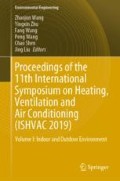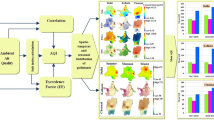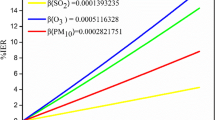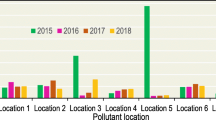Abstract
China has been experiencing and suffering in a serious air pollution problem these years and has brought air quality into spotlight. Air pollution is a key factor of indoor air quality and has a considerable impact on the public health and indoor occupants’ activities. China still adopts air quality index (AQI) and primary pollutant for assessing the degree of air pollution, which ignore the effects of non-primary pollutants during the same period and the dynamic characteristics of all pollutants. In order to consider the comprehensive impact of various pollutants on air quality, the total air quality index (TAQI) is proposed as an indicator to measure the total air quality. A new index, contribution rate (IAQIP/TAQI), is further proposed as the contribution of a pollutant to total air quality, which may be much different from the chief pollutant. In this study, the daily average values of six pollutants’ concentrations in thirty-one provincial capital nationwide from 2014 to 2017 are used as data sources. According to these indexes, the dynamic characteristic of local air pollutant composition is studied and explored. The indexes proposed in this study have a guiding significance for improving air quality evaluation and help create better indoor air environment in different regions.
Similar content being viewed by others
Keywords
1 Introduction
Outdoor air quality is a key factor determining indoor air quality due to (natural and mechanical) ventilation requirement of people. However, if the outdoor pollution is serious, the indoor air will be greatly affected. In recent decades, due to the rapid development of industrialization and urbanization, energy consumption has increased. China has been experiencing serious air pollution problems which lowers urbanites’ happiness and increases the risk of human health [1], and the Environmental Performance Index 2018 illustrates that China is the fourth worst country among 180 countries in outdoor air quality [2]. Therefore, measuring air quality and understanding air pollution situation are critical to ensure indoor and outdoor human health.
The World Health Organization (WHO) has been concerned the impact of air quality on human health for more than a half century, and the latest version of air quality guidelines has been released in 2005 which provides reference for countries to formulate air quality indexes, including PM2.5, PM10, SO2, NO2, CO, and O3 (defined as the six criteria pollutants) [3]. Currently, the air quality index (AQI) basing on the United States Environmental Protection Agency (US EPA) is used by most countries. The primary purpose of AQI is that people could convert the concentration of the six pollutants into a single comparable index value. However, AQI has been criticized as not comprehensive enough because it only considers the most serious pollutant and ignores the combined effects of multiple pollutants.
There have been some researches that improve AQI to describe the comprehensive effect of multiple pollutants [4, 5]. Swamee and Tyagi [6] proposed an aggregating function among pollutants by summing all sub-indexed of pollutants which were considered in equal weights to form an aggregate AQI (AAQI). Kyrkilis et al. [7] adopted this index to the area of Athens, Greece. Another comprehensive index is Air Quality Health Index (AQHI) which indicates the health risk associated with exposure to multiple air pollutants. The relative risks for respiratory and cardiovascular diseases associated with several air pollutants were obtained by time-series studies. Canada has been using the AQHI which is based on the approach proposed by Stieb et al. [8], and a few years later, Hong Kong developed AQHI based on the Canadian approach by Wong et al. [9].
The Chinese Ministry of Environmental Protection (MEP) developed the Chinese AQI system based on the US EPA AQI approach in 2012 [10]. In this study, the daily average values of six pollutants’ concentrations in thirty-one provincial capital nationwide from 2014 to 2017 are used as data sources. Total air quality index (TAQI) is calculated to describe the combined health effects of multiple pollutants based on Chinese AQI system. By comparing the trend between TAQI and AQI, a contribution rate is proposed to reveal the contribution of one pollutant to total air pollution. Referring to contribution rate, cumulative chief pollutant (CCP) and original chief pollutant (CP) are compared to show the current situation and trend of air pollution in China in the past four years. These new indexes proposed in this study will have an important significance for the evaluation of air quality and maintenance of indoor and outdoor air environment.
2 Methodology
2.1 New Air Quality Index
AQI and Chief pollutant. The AQI simplifies the concentration of several air pollutants that are routinely monitored into a single conceptual index value form, which will indicate the air pollution level and air quality status. The individual air quality index is also specified for individual pollutants, and the degree of contamination of various pollutants is converted to a numerical value for comparison. The main pollutants involved in air quality assessment are PM2.5, PM10, SO2, NO2, CO, and O3. Individual air quality index (IAQI) of each pollutant is calculated as Eq. (1), and corresponding pollutant concentration limit are shown in Table 1.
where IAQIP is the index of pollutant P, CP is the mass concentration of pollutant P, BPHi is the high value which is close to CP in Table 1, BPLo is the low value which is close to CP in Table 1, IAQIHi is the IAQI which is corresponding to the BPHi in Table 1, and IAQILo is the IAQI which is corresponding to the BPLo in Table 1.
The AQI is the maximum value of all six IAQIP. Air quality can be defined in six levels by AQI, and the interval range and its impact of each level are also shown in Table 1.
When AQI is greater than 50, a pollutant which has the largest IAQI value is the chief pollutant on that day. A pollutant that becomes the chief pollutant in most days is the chief pollutant in this year.
TAQI and Cumulative chief pollutant (CCP). As AQI only considers the most serious pollutant, it could not indicate the effect of the other pollutants. In order to describe the comprehensive effect of all six pollutants, TAQI is proposed based on AQI. Assuming that effects of individual pollutants are additive, TAQI is the sum of IAQIP. The AQI approach stipulates that there exists a chief pollutant when AQI is greater than 50. If the IAQIP less than or equal to 50, it is considered that air quality has no effect on health of people, so TAQI value just aggregates the IAQIPs which are greater than 50 based on the same principle.
The contribution rate of each pollutant is defined as the ratio of IAQIP and TAQI, as shown in Eq. (2):
The ratio of the total IAQIP to the total value of TAQI is the contribution rate of a certain pollutant in this year. The pollutant which has the largest contribution rate is treated as the CCP this year.
2.2 Meteorological Data
In order to understand the performance of indexes in China, thirty-one cities were selected for this study including four municipalities (Beijing, Shanghai, Tianjin, Chongqing) and other twenty-seven provincial capitals. The locations of the target cities are shown in Fig. 1.
The concentration of atmospheric pollutants in China is measured by the national air quality monitoring sites distributed in each city, and the data is obtained from Beijing Meteorological Bureau. 24-hour average concentrations of PM2.5, PM10, SO2, NO2, CO and 8-hour moving average (maximum) of O3 from January 1, 2014, to December 31, 2017, are included in this study.
3 Results
3.1 AQI and IAQI
TAQI is a new index, and it is necessary to compare it with AQI, while it is difficult to compare two indexes directly. Times is defined as \(T = \frac{{\text{TAQI}}}{{\text{AQI}}}\), \(T_{\text{day}} = \frac{{{\text{TAQI}}_{\text{day}} }}{{{\text{AQI}}_{\text{day}} }}\) can be obtained by the data every day, and Tyear is the annual average of Tday of one city. Comparing Tday and Tyear is an easy way to figure the difference between AQI and TAQI, and the fluctuation could be calculated as Eq. (3):
Taking the data of Beijing in 2017 as an example for analysis, the Tyear is calculated equals to 2.16. In this analysis, a situation is deleted as no meaning. When the AQI less than or equal to 50, TAQI equals to 0, which means there is no pollution that day. The fluctuation condition is shown in Fig. 2.
From Fig. 2, the fluctuation between Tday and Tyear could be recognized obviously. The maximum Tday is 3.86 with the error of 78.70%, while the minimum Tday is 1.00 with the error of 53.70%, which means that there is only one pollutant causes pollution that day, and in this case, TAQI = AQI = IAQIP. It can be concluded that the AQI value has a big difference with TAQI.
3.2 Contribution Rate
With the index of TAQI and with the overall national pollution data, the extent of the cumulative impact of the six pollutants in a year could be investigated, and the average contribution rate of six pollutants among thirty-one cities in the past four years could be counted, as shown in Fig. 3.
It can be seen from the Fig. 3 that the composition of the six pollutants has not changed greatly in the past four years, and the contribution rate of the particulate matter (PM2.5 and PM10) stays above 70%. It is worth noting that the contribution rate of NO2 is increasing year by year and it now raises to 20% and accounts for the largest proportion of gaseous pollutants.
Then, the contribution rates of six pollutants of thirty-one cities in 2017 are analyzed and arranged in order of the pollution severity, as shown in Fig. 4.
As seen from Fig. 4, the result shows some certain differences in the composition of pollutants between the cities of the north and the south part of China. All six pollutants exist in the northern cities at the same time, while the types of pollutants in the southern cities are usually particulate matters (PM2.5 and PM10), NO2 and O3. In addition, the pollution caused by NO2 is should be noticed. In general, the contribution rate reaches 20% in most regions, and it could reach beyond 30% in some big city such as Chongqing and Shanghai and 41.33% in Guangzhou.
3.3 Chief Pollutant and CCP
Chief pollutant is used to generalize the pollution situation of a season or a year for a country. Now, CCP is proposed to indicate which pollutant has the largest contribution rate around the whole year. As chief pollutant and CCP have different definitions, they will be inconsistent even with the same data. For this reason, chief pollutants and CCP are calculated and compared within a total of one hundred twenty-four (thirty-one cities with four years) years’ data. The comparison details including cities, years, chief pollutants, and CCP are shown in Table 2.
It can be seen from Table 2 that seventeen years’ data show some in-consistence. The results illustrate the difference between chief pollutant and CCP is mainly between PM2.5 and PM10. There takes up 13.7% of one hundred twenty-four years. The trend could be also concluded as this phenomenon of in-consistence happens more and more in recent years and these seventeen samples include three cases in 2014, three cases in 2015, four cases in 2016, and seven cases in 2017. CCP may become a new reasonable index for recognizing chief pollutant in the future.
4 Discussion
This study proposes TAQI and contribution rate to evaluate air quality by describing the pollution situation caused by six pollutants in the past four years. However, TAQI lacks of the evidence with public health, which will be one of the important directions in the future. The benchmarks of each IAQIP will be investigated and compared with other indexes in the future.
5 Conclusion
A new air quality index TAQI which considers comprehensive health effects of multiple pollutants is proposed based on AQI, and contribution rate is further proposed as the contribution of each pollutant. The results show that PM2.5, PM10, and NO2 are the primary pollutants among those six pollutants, and NO2 becomes shining in recent years which should arise public awareness. The composition of pollutants has been found significantly different between southern and northern cities.
The number of the in-consistence time between chief pollutant and CCP has been found increasing year by year, which indicates TAQI and CCP are better indexes to present the outdoor air quality. With these results, the most serious pollutant could be easily recognized and policy could be made for building a better outdoor and indoor air environment accordingly.
References
Zheng, S., Wang, J., Sun, C., Zhang, X., Kahn, M.E.: Air pollution lowers Chinese urbanites’ expressed happiness on social media. Nat. Hum. Behav. 1 (2019)
Center, Y., Driven, Y.D.: The Environmental Performance Index Ranks Countries Performance on High-Priority Environmental Issues (2018)
World Health Organization: World Health Organization Air Quality Guidelines—global update. Report on a Working Group meeting, Bonn, Germany (2005)
Cairncross, E.K., John, J., Zunckel, M.: A novel air pollution index based on the relative risk of daily mortality associated with short-term exposure to common air pollutants. Atmos. Environ. 41(38), 8442–8454 (2007)
Sicard, P., Lesne, O., Alexandre, N., Mangin, A., Collomp, R.: Air quality trends and potential health effects—development of an aggregate risk index. Atmos. Environ. 45(5), 1145–1153 (2011)
Swamee, P.K., Tyagi, A.: Formation of an air pollution index. J. Air Waste Manag. Assoc. 49(1), 88–91 (1999)
Kyrkilis, G., Chaloulakou, A., Kassomenos, P.A.: Development of an aggregate Air Quality Index for an urban Mediterranean agglomeration: relation to potential health effects. Environ. Int. 33(5), 670–676 (2007)
Stieb, D.M., Burnett, R.T., Smith-Doiron, M., Brion, O., Shin, H.H., Economou, V.: A new multipollutant, no-threshold air quality health index based on short-term associations observed in daily time-series analyses. J. Air Waste Manag. Assoc. 58(3), 435–450 (2008)
Wong, T.W., San Tam, W.W., Yu, I.T.S., Lau, A.K.H., Pang, S.W., Wong, A.H.: Developing a risk-based air quality health index. Atmos. Environ. 76, 52–58 (2013)
China, M.E.P.: Technical Regulation on Ambient Air Quality Index (on Trial) (HJ633-2012). China Environmental Science Press, Beijing, China (2012)
Acknowledgements
This work was supported by National Key R&D Program of China (2018YFC0705202-02), and it is also a part of National Natural Science Foundation of China, Youth Program (51808011).
Author information
Authors and Affiliations
Corresponding author
Editor information
Editors and Affiliations
Rights and permissions
Copyright information
© 2020 Springer Nature Singapore Pte Ltd.
About this paper
Cite this paper
Guo, J., Xue, P., Zhao, M., Fan, G., Ding, B., Liu, J. (2020). A Primary Study of New Indexes for Air Pollutant. In: Wang, Z., Zhu, Y., Wang, F., Wang, P., Shen, C., Liu, J. (eds) Proceedings of the 11th International Symposium on Heating, Ventilation and Air Conditioning (ISHVAC 2019). ISHVAC 2019. Environmental Science and Engineering(). Springer, Singapore. https://doi.org/10.1007/978-981-13-9520-8_109
Download citation
DOI: https://doi.org/10.1007/978-981-13-9520-8_109
Published:
Publisher Name: Springer, Singapore
Print ISBN: 978-981-13-9519-2
Online ISBN: 978-981-13-9520-8
eBook Packages: Earth and Environmental ScienceEarth and Environmental Science (R0)








